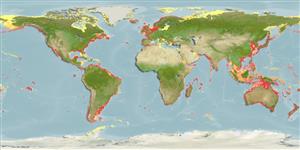Common names from other countries
Environment: milieu / climate zone / depth range / distribution range
Ecologia
; intervalo de profundidade 0 - 80 m (Ref. 1603). Tropical; 68°N - 76°S, 180°W - 180°E
Circumglobal.
Length at first maturity / Tamanho / Peso / Idade
Maturity: Lm ? range ? - ? cm Max length : 0.1 cm TL macho/indeterminado; (Ref. 2226)
Assumed maximum length of zooids from Ref. 2226. Found also on dead corals. Attached to hard substrata (Ref. 1603); from low water level (Ref. 226) to depth of about 80 m (Ref. 1603); occurs in mangrove ponds (Ref. 1758). Colonial (Ref. 415).
Life cycle and mating behavior
Maturidade | Reprodução | Desova | Ovos | Fecundidade | Larvas
Members of the class Ascidiacea are hermaphroditic; both cross- and self-fertilization is typical. Life cycle: Eggs develop into lecithotrophic larva before metamorphosing into benthic adults.
Sanamyan, K. and D. Schories. 2004. (Ref. 3379)
Categoria na Lista Vermelha da IUCN (Ref. 130435)
Categoria CITES (Ref. 108899)
Not Evaluated
Not Evaluated
Utilização humana
| FishSource |
Ferramentas
Mais informação
Idade/TamanhoCrescimentoComprimento-pesoComprimento-comprimentoMorfologiaLarvasAbundância
Fontes da internet
Estimates based on models
Preferred temperature
(Ref.
115969): 7.3 - 27.9, mean 18.3 (based on 3200 cells).
Vulnerabilidade
Low vulnerability (10 of 100).
Categoria de preço
Unknown.
